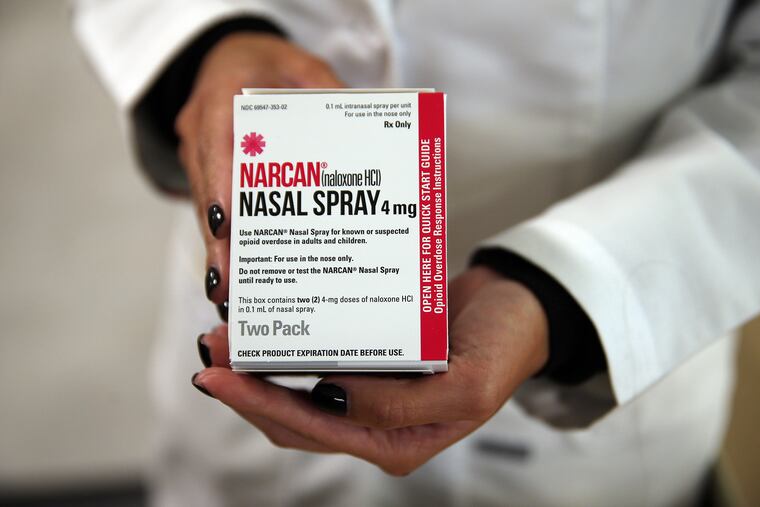Pain patients on opioids also are getting rescue drug naloxone to prevent overdose
Physicians say it’s a harm-reduction measure for a population who risks overdose even if they are taking their medication as prescribed.

Increasingly, pain patients who need high doses of opioids are getting another medicine prescribed alongside them: the overdose-reversing spray naloxone, more often associated with illicit drug use.
According to a new report from Kaiser Health News, a handful of states — including Ohio, which, with Pennsylvania, is one of the states hit hardest by the overdose crisis — now require physicians to prescribe naloxone along with high doses of opioids or to pain patients who have dealt with substance use disorder.
In Pennsylvania, there are no laws requiring physicians to do so, but last year the state Health Department updated its physician guidelines to recommend doctors prescribe naloxone for anyone receiving a dose of opioids higher than 50 morphine milligram equivalents per day. (The state also has a standing order for naloxone, so pharmacies can dispense it to anyone without a prescription.)
Physicians here say distributing naloxone is a harm-reduction measure for patients at risk of overdose even if they are taking their medication as prescribed.
“People who are prescribed opioids for treatment of either acute or chronic pain can experience side effects, and those side effects include respiratory arrest and death,” said Michael Ashburn, a professor in the University of Pennsylvania’s department of anesthesiology and critical care who directs the Penn Pain Medicine Center. “Even with well-meaning doctors, [patients are] at increased risk of death if they take these [opioid] medications than if they don’t.”
Ashburn helped write the state’s new guidelines around prescribing naloxone for pain patients. He said he doesn’t think state legislatures should have to set rules like this into law, noting Health Department guidelines can better keep up with the latest research. “I think that it’s very hard for state legislatures to keep up with best practice and to be as flexible as experts can be,” he said.
But, he said, it’s important to make it easy for doctors to follow the state’s guidelines. Penn is working to develop an alert system that reminds doctors to prescribe naloxone when they order high doses of opioids for a patient, and a data dashboard that updates them on whether they’re prescribing naloxone often enough.
Some pain patients told Kaiser they feared being stigmatized with a substance use disorder if they were prescribed naloxone — or that they simply didn’t need it. But Ashburn said the guideline is simply about getting people proper care. “Everyone deserves to have a resuscitation drug immediately available,” he said.
Still, some physicians point out that people who are overdosing can’t dose themselves with naloxone. And people using opioid drugs as prescribed typically risk respiratory failure in their sleep, said Eugene Viscusi, chief of pain medicine at Thomas Jefferson University Hospital. “Unless someone is monitoring your sleep or watching you,” a patient might not get a dose of naloxone until it’s too late, he said. “But it’s not that the policy is wrong or misplaced — if you’re getting naloxone out into the community, it will get used.”
Viscusi says he practices harm reduction with pain patients by trying “every other option” before prescribing an opioid, and then at the lowest doses possible.
Leonard Kamen, a pain doctor at Moss Rehab in Northeast Philadelphia, said that before prescribing opioids, he screens patients carefully to find out if they are using other medications, including benzodiazepines like Xanax. These antianxiety medicines, when taken with opioids, raise the risk of an overdose. He has also used buprenorphine, an opioid-based drug typically used for addiction treatment, to treat pain, since it carries a lower risk of overdose than opioid pain pills.
Prescribing naloxone with opioid medications, he said, isn’t just a precaution for his patients — it’s for everyone in their household.
“People look at me and say, ‘Why do I need to have this?’ And I say, it’s because you have young children, or teenagers, and maybe it’s not your kid, but it’s your kid’s friends,” he said. “You have to cover that spectrum when you’re using these medications.”